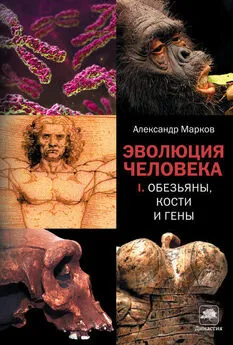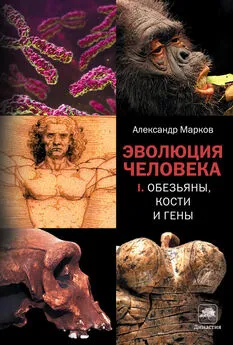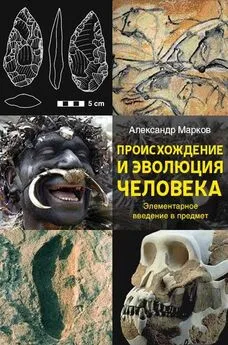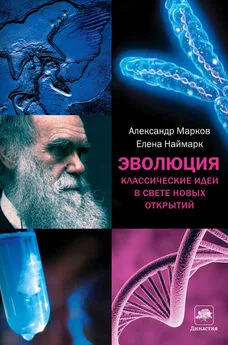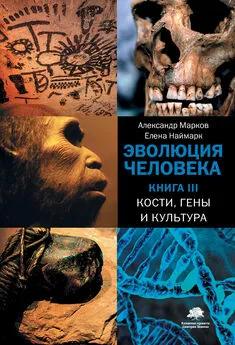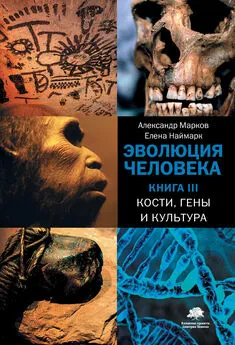Александр Марков - Эволюция человека том 1: Обезьяны кости и гены 2011
- Название:Эволюция человека том 1: Обезьяны кости и гены 2011
- Автор:
- Жанр:
- Издательство:неизвестно
- Год:неизвестен
- ISBN:нет данных
- Рейтинг:
- Избранное:Добавить в избранное
-
Отзывы:
-
Ваша оценка:
Александр Марков - Эволюция человека том 1: Обезьяны кости и гены 2011 краткое содержание
Эволюция человека том 1: Обезьяны кости и гены 2011 - читать онлайн бесплатно ознакомительный отрывок
Интервал:
Закладка:
GREEN R. E., KRAUSE J., BRIGGS A.W., ET AL. 2010. A Draft Sequence of the Neandertal Genome // Science. V. 328. P. 710—722.
GRIGGIO М., HOI Н. 2010. Only females in poor condition display a clear preference and prefer males with an average badge // BMC Evolutionary Biology V 10. P. 261.
GUNZ P., NEUBAUER S., MAUREILLE В., HUBLIN J.-J. 2010. Brain development after birth differs between Neanderthals and modern humans // Current Biology V 20. P. R921 — R922.
HABGOOD P. J., FRANKLIN N. R. 2008. The revolution that didn't arrive: A review of Pleistocene Sahul // Journal of Human Evolution. V. 55. P. 187—222.
HAILE-SELASSIE Y., LATIMER B.M., ALENE M, ET AL. 2010. An early Australopithecus afarensispostcranium from Woranso-Mille, Ethiopia // Proc.Nat. Acad. Sci. USA. V 107. P. 12121—12126.
HEINZELIN J. DE, CLARK J.D., WHITE Т., ET AL. 1999. Environment and behavior of 2.5-million-year-old Bouri hominids // Science. V. 284. P. 625—629.
HENDRIE C. A., MANNION H. D., GODFREY G. K. 2009. Evidence to suggest that nightclubs function as human sexual display grounds // Behaviour. V 146. P. 1331—1348.
HENRICH J. 2004. Demography and Cultural Evolution: Why adaptive cultural processes produced maladaptive losses — The Tasmanian Case // American Antiquity. V 69 (2). P. 197—214.
HIGHAM Т., JACOBI R., JULIEN M., ET AL. 2010. Chronology of the Grotte du Renne (France) and implications for the context of ornaments and human remains within the Chdtelperronian // Proc.Nat. Acad. Sci. USA. V. 107 (47). P. 20234—20239.
HOCKINGS K.J., HUMLE Т., ANDERSON J. R., ET AL. 2007. Chimpanzees Share Forbidden Fruit // PLoS ONE. V. 2 (9). P. e886.
HOLST PELLEKAAN S. M. VAN, INGMAN M., ROBERTS-THOMSON J., HARDING R. M. 2006. Mitochondrial Genomics Identifies Major Haplogroups in Aboriginal Australians // American Journal of Physical Anthropology. V 131. P. 282—294.
HOLVECK M. J., RIEBEL K. 2010. Low-quality females prefer low-quality males when choosing a mate // Proc R Soc Lond В. V 277. P. 153—160.
HOWRIGAN D. P., MACDONALD К. В. 2008. Humor as a mental fitness indicator // Evolutionary Psychology. V 6. P. 652—666.
HUMPHREY N. K. 1974. Species and individuals in the perceptual world of monkeys // Perception. V 3. P. 105—114.
ISAAC G. 1982. Early Hominids and Fire at Chesowanja, Kenya // Nature. V. 296. P 870.
JACOB Т., INDRIATI E., SOEJONO R. P., ET AL. 2006. Pygmoid Australomelanesian Homo sapiens skeletal remains from Liang Bua, Flores: Population affinities and pathological abnormalities // Proc.Nat. Acad. Sci. USA. V. 103. P. 13421—13426.
JACOBS Z., ROBERTS R. G., GALBRAITH R. R, ET AL. 2008. Ages for the Middle Stone Age of Southern Africa: Implications for Human Behavior and Dispersal // Science. V 322. P. 733—735.
JOLLY C.J., WOOLLEY-BARKER Т., BEYENE S., ET AL. 1997. Intergeneric Hybrid Baboons // International Journal of Primatology. V 18. P. 597—627. Journal of Human Evolution. 2008. V. Issue 3 (специальный выпуск, посвященный древнейшим "анатомически современным людям" из Омо).
JUNGERS W. L., HARCOURT-SMITH W. Е. Н., WUNDERLICH R. Е., ET AL. 2009. The foot of Homo floresiensis // Nature. V. 459. P. 81—84.
KAISER S.M., MALIK H.S., EMERMAN M. 2007. Restriction of an Extinct Retrovirus by the Human TRIM fa Antiviral Protein // Science. V 316. P. 1756—1758.
KJELDBJERG A. L., VILLESEN P., AAGAARD L., PEDERSEN F. S. 2008. Gene conversion and purifying selection of a placenta-specific ERV-V envelope gene during simian evolution // BMC Evolutionary Biology. V 8. P. 266.
KONOPKA G., BOMARJ.M., WINDEN K., ET AL. 2009. Human-specific transcriptional regulation of CNS development genes by FOXP2 // Nature. V. 462. P. 213—217.
KRAUSE J., ORLANDO L., SERRE D., ET AL. 2007. Neanderthals in central Asia and Siberia // Nature. V 449. P. 902—904.
KRAUSE J., FU Q., GOOD J.M., ET AL. 2010. The complete mitochondrial DNA genome of an unknown hominin from southern Siberia // Nature. V. 464. P. 894—897.
KRUGER D.J. 2008. Male Financial Consumption is Associated with Higher Mating Intentions and Mating Success // Evolutionary Psychology. V 6. P. 603—612.
LALUEZA-FOX C., ROMPLER C., CARAMELLI D., ET AL. 2007. A melanocortin 1 receptor allele suggests varying pigmentation among Neanderthals // Science. V 318. P. 1453—1455.
LALUEZA-FOX C., ROSAS A., ESTALRRICH A., ET AL. 2011. Genetic evidence for patrilocal mating behavior among Neandertal groups // Proc.Nat. Acad. Sci. USA. V 108. P. 250—253.
LEE-THORP J., THACKERAY J. F., VAN DER MERWE N. 2000. The hunters and the hunted revisited // Journal of Human Evolution. V 39 (6). P. 565—576.
LEIGH S. R. 2006. Brain ontogeny and life history in Homo erectus // Journal of Human Evolution. V. 50. P. 104—108.
LENTS N. H., CIFUENTES О. E., CARPI A. 2010. Teaching the Process of Molecular Phylogeny and Systematics: A Multi-Part Inquiry-Based Exercise // СBE Life Sci Educ. V. 9. P. 513—523.
LEWIS M. E. 1997. Carnivoran paleoguilds of Africa: implications for hominid food procurement strategies //Journal of Human Evolution. V32. P. 257—288.
LIEBERMAN D. Е. 2009. Homo floresiensis from head to toe // Nature, v. 459. p. 41—44.
LOCKWOOD C.A., MENTER C. G., MOGGI-CECCHI J., KEYSER A.W. 2007. Extended Male Growth in a Fossil Hominin Species // Science. V. 318. P. 1443—1446.
LORDKIPANIDZE D., JASHASHVILI Т., VEKUA A., ET AL. 2007. Postcranial evidence from early Homo from Dmanisi, Georgia // Nature. V. 449. P. 305—310.
LOVEJOY С. O. 1981. The Origin of Man // Science. V. 211. P. 341—350.
LOVEJOY С. O. 2009. Reexamining Human Origins in Light of Ardipithecus ramidus // Science. V. 326. P. 74.
MARTIN R. D., MACLARNON A. M., PHILLIPS J. L., ET AL. 2006. Comment on "The Brain of LB1, Homo floresiensis" // Science. V. 312. P. 999.
MCPHERRON S. P., ALEMSEGED Z., MAREAN C. W., ET AL. 2010.Evidence for stone-tool-assisted consumption of animal tissues before 3.39 million years ago at Dikika, Ethiopia // Nature. V. 466. P. 857—860.
MELLARS P. 2006. A new radiocarbon revolution and the dispersal of modern humans in Eurasia // Nature. V. 439. P. 931—935.
MILLER G. 2000. The Mating Mind: How Sexual Choice Shaped the Evolution of Human Nature , http://evolbiol.ru/large_files/miller_the_mating_mind.pdf
MILLER G. H., FOGEL M. L., MAGEE J. W., ET AL. 2005. Ecosystem Collapse in Pleistocene Australia and a Human Role in Megafaunal Extinction // Science. V. 309. P. 287—290.
MOORE M. W., SUTIKNA Т., JATMIKO, ET AL. 2009. Continuities in stone flaking technology at Liang Bua, Flores, (Indonesia) // Journal of Human Evolution. V. 57. P. 503—526.
NATION I. S. P. 2006.How large a vocabulary is needed for reading and listening // Canadian Modern Language Review. V. 63. P. 59—82.
NETTLE D. 2010. Understanding of Evolution May Be Improved by Thinking about People // Evolutionary Psychology. 2010. V. 8. P. 205—228.
NOONAN J. P., COOP G., KUDARAVALLI S., ET AL. 2006. Sequencing and Analysis of Neanderthal Genomic DNA // Science. V. 314. P. 1113—1118.
OLIVIERI A., ACHILLI A., PALA M., ET AL. 2006. The mtDNA Legacy of the Levantine Early Upper Palaeolithic in Africa // Science. V. 314. P. 1767—1770.
PARFITT S. A., BARENDREGT R. W., BREDA M., ET AL. 2005. The earliest record of human activity in northern Europe // Nature. V. 438. P. 1008—1012.
PETRAGLIA M., KORISETTAR R., BOIVIN N., ET AL. 2007. Middle Paleolithic Assemblages from the Indian Subcontinent Before and After the Toba Super-Eruption // Science. V. 317. P. 114—116.
PONCE DE LEON M.S., GOLOVANOVA L., DORONICHEV V., ET AL. 2008. Neanderthal brain size at birth provides insights into the evolution of human life history // Proc.Nat. Acad. Sci. USA. V. 105 (37). P. 13764—13768.
POWELL A., SHENNAN S., THOMAS M. 2009. Late Pleistocene Demography and the Appearence of Modern Human Behavior // Science. V. 324. P. 1298—1301.
PRATO-PREVIDE E., FALLANI G., VALSECCHI P. 2006. Gender Differences in Owners Interacting with Pet Dogs: An Observational Study // Ethology. V. 112. P. 64—73.
PRIDEAUX G.J., LONG J. A., AYLIFFE L. K., ET AL. 2007. An arid-adapted middle Pleistocene vertebrate fauna from south-central Australia // Nature. V. 445. P. 422—425.
RAMIREZ R. F. V., D'ERRICO F., VANHAEREN M., ET AL. 2009. Cutmarked human remains bearing Neandertal features and modern human remains associated with the Aurignacian at Les Rois // Journal of Anthropological Sciences. V. 87. P 153-185.
REICH D., GREEN R. E., KIRCHER M., ET AL. 2010. Genetic history of an archaic hominin group from Denisova Cave in Siberia // Nature. V. 468. P. 1053—1060.
RAICHLEN D. A., GORDON A. D., HARCOURT-SMITH W. E., ET AL. 2010. Laetoli Footprints Preserve Earliest Direct Evidence of Human-Like Bipedal Biomechanics // PLoS One. V. 5 (3). P. 69769.
ROBINSON B. W., WILSON D. S. 1998. Optimal foraging, specialization, and a solution to Liem's paradox // American Naturalist. V. 151. P. 223—235.
ROGAEV E. I., GRIGORENKO A. P., MOLIAKA Y. K., ET AL. 2009. Genomic identification in the historical case of the Nicholas II royal family // Proc. Natl. Acad. Sci. USA. V 106. P. 5258—5263 (популярное изложение: Генетический анализ показал, что из детей Николая II не спасся никто, http://elementy.ru/news/431018)
ROSENBERG J., TUNNEY R.J. 2008. Human vocabulary use as display // Evolutionary Psychology. V. 6. P. 538—549.
ROSSO L., MARQUES А. С., WEIER M., ET AL. 2008. Birth and Rapid Subcellular Adaptation of a Hominoid-Specific CDC 14 Protein // PLoS Biology. V. 6. P. e140.
SCHICK K. D., TOTH N., GARUFI G., ET AL. 1999. Continuing Investigations into the Stone Tool-making and Tool-using Capabilities of a Bonobo (Pan paniscus) //Journal of Archaeological Science. V. 26 (7). P. 821—832.
SCHLUPP I., RIESCH R., TOBLER M., ET AL. 2010. A novel, sexually selected trait in poeciliid fishes: female preference for mustache-like, rostral filaments in male Poecilia sphenops // Behavioral Ecology and Sociobiology. V. 64 (11). P. 1849—1855.
Читать дальшеИнтервал:
Закладка:

